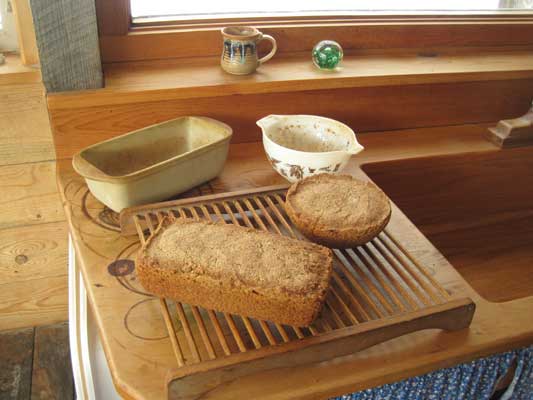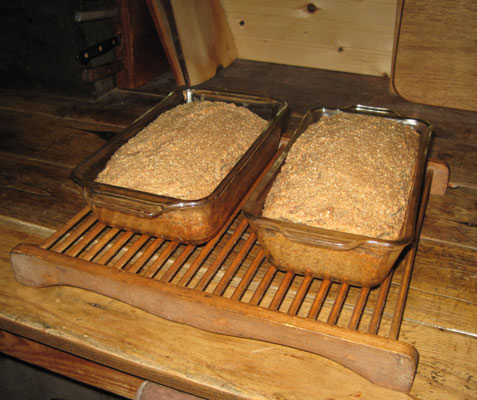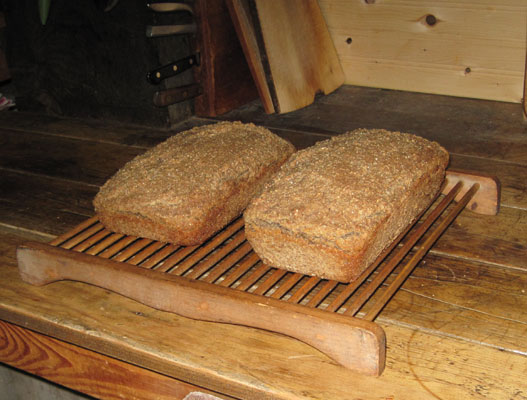It’s April, we’re still getting snow, temperature lows often diving down to
zero and highs are having a hard time getting above freezing. Might as well bake
some bread! Well, I bake bread almost every week but having the wood cookstove
going and the smells of baking bread seem most welcome when winter is reluctant
to give way to spring.
My first home baked bread was more than forty years ago when we were living in
the city, dreaming of our future homestead. We bought a grain mill to grind our
own flour (which we still have and use) and that first loaf turned out! We were
hooked.
Many hundreds of loaves, many variations tried, and many decades later I still
enjoy baking bread. It’s so easy, and so satisfying. For years it was all wheat,
then rye and barley joined in. At some point I changed from wheat to spelt. A
small amount of buckwheat usually. This has been my basic flour mix for some
time, making a nicely dense, tasty bread. Sometimes it was made in a regular
bread pan, sometimes rolls, most often a long “roll” on a cookie sheet. I found
this to bake the best and became my standard. But nothing ever stays still. How
boring it would be if it did!
This year my mix became more multi-grained with additions to the above of
oats, millet, quinoa, corn, and always a few tablespoons of fennel. The
smell of fennel fills the air when the mix is grinding! Maybe I got a little
carried away when I ordered the grains, but we like the resulting flavor and
texture. Fun, but maybe a bit more fussy than I like. I have a feeling next
year I'll go back to my basic spelt, barley, rye, maybe oat groats. We like
that, too.
I found early on that bread is really quite forgiving. I did make a couple
of compostable 'bricks' in the early days learning to deal with the vagaries of
a wood cookstove. But soon baking bread of whatever shape or design became a
simple chore, easy to fit into our busy schedules. It was like any number of
things that you do again and again. You soon become a “master” of your own
recipe and it is no longer difficult. But with changes comes the chance to
learn some new tricks. And with my new flour mix I had need for some new
learning.
I wanted
a lighter crumb; something with a moderate amount of holes, small ones,
something that would trap the jam when you wanted to make a PB&J sandwich
and eat it on the road and not have jam squeezing out on your lap or hands.
My regular bread just wasn’t very good at that.
So I did some searching online. Wow, what a big bug baking your own bread
has become! That’s great, though I find some of the rules and have-to’s to
be quite tiresome. Bread baking really isn’t that difficult! Nor that
exacting. However, I did get some hints. Mainly, make the dough wetter. Mmm.
OK, I can do that. I’ve never been a big fan of kneading anyway so always did the
minimum but i'm happy to skip that part. It took me a few tries to get
what I wanted but this is my current regime:
* Put 2 cups of warm water in bowl. Sprinkle 1/2 tsp bread yeast across
surface.
* Add/mix in flour until sort of like thick cream soup.
* Cover and let set for awhile (likely a few hours) until it’s working
(bubbles in surface).
* Stir in some oil, maybe 1/4 cup. Add flour until the dough is sticky but
holds its shape (if the bread doesn’t come out the way you like it next time
try wetter or drier dough - this is what took me a few tries to get right.)
* Scrape into well oiled pan(s)/baking dish(es)**.
* Pat/push/flatten/shape however you want the top to be. I like a flat top
so I flatten/smooth it with a wet spoon.
* Cover and let rise. Mine doesn’t double, maybe rises a quarter. Maybe
takes a few hours.
* Bake in a fairly hot oven for 40-60 minutes. Cover with aluminum foil when
the top is lightly browned and getting hard. Bake until it is nicely browned
around the edges.
* Let it set a bit, run a butter knife or metal spatula around the edges, then turn it out onto
cooling rack.
* Let it cool before cutting and eating.
 **
Baking pans - My former cookie-sheet method didn’t work so well with the
moister dough. It just slowly spread out instead of rising up making a
nicely baked but very wide short “loaf”. This was OK for single
slice eating
but it didn’t get high marks for sandwiches. So I dug out the old bread pans
I had. They worked OK for baking the bread but didn’t do so well for getting
the loaf out in one piece. My usual method of oiling the pan with vegetable
oil apparently wasn’t enough. But I didn’t find any other suggestions that I
cared for. So I figured it was time for a new bread pan. Mine were pretty
well dented and scratched.
**
Baking pans - My former cookie-sheet method didn’t work so well with the
moister dough. It just slowly spread out instead of rising up making a
nicely baked but very wide short “loaf”. This was OK for single
slice eating
but it didn’t get high marks for sandwiches. So I dug out the old bread pans
I had. They worked OK for baking the bread but didn’t do so well for getting
the loaf out in one piece. My usual method of oiling the pan with vegetable
oil apparently wasn’t enough. But I didn’t find any other suggestions that I
cared for. So I figured it was time for a new bread pan. Mine were pretty
well dented and scratched.
At about that time I spied a small clay bread pan at the thrift store. I’d
read about them and thought I’d give it a try. Oiled it well, filled it
about 3/4. Had dough left. Mmm. Grabbed a small Pyrex mixing bowl, oiled it,
put the rest of the dough in that. It would do I figured. Well, they both
‘did’ and very well at that! Just right for this bread. Baked well all the
way through with a very nice crust, and came out easily in one piece! I
might get another clay/stoneware bread pan, but then again, maybe not. I
rather like the round loaf from the Pyrex mixing bowl.
-- April
2018
More Bread
 Awhile
ago I mentioned baking my 100% whole grain bread in an unglazed pottery
pan and a Pyrex bowl, which worked well. Then I spied some glass bread
pans at the thrift store and decided to give them a try. They were a
success! And are what I am now using. They work equally well as far as
baking as the unglazed pan and the Pyrex bowl but with the added benefit
of being able to
Awhile
ago I mentioned baking my 100% whole grain bread in an unglazed pottery
pan and a Pyrex bowl, which worked well. Then I spied some glass bread
pans at the thrift store and decided to give them a try. They were a
success! And are what I am now using. They work equally well as far as
baking as the unglazed pan and the Pyrex bowl but with the added benefit
of being able to
 see
the bottom of the bread when trying to decide if it is indeed baked long
enough. This is a big plus when dealing with the vagaries not only of
bread dough but the uneven heating of the wood cookstove over an hour's
time. I've found the bread easy to remove from the oiled pans if left to
cool a bit until still warm but not hot or cold. A quick slice down the
sides of the glass pan with metal spatula and it comes out easily onto
the cooking rack. This also helps prevent the 'problem' of someone
slicing off a piece of freshly baked bread before it has cooled enough
to be at its best. By the time it's ready to come out of the glass
baking dish it is still warm enough for the butter to melt and just
right for eating. Just what is needed on a cold winter evening
see
the bottom of the bread when trying to decide if it is indeed baked long
enough. This is a big plus when dealing with the vagaries not only of
bread dough but the uneven heating of the wood cookstove over an hour's
time. I've found the bread easy to remove from the oiled pans if left to
cool a bit until still warm but not hot or cold. A quick slice down the
sides of the glass pan with metal spatula and it comes out easily onto
the cooking rack. This also helps prevent the 'problem' of someone
slicing off a piece of freshly baked bread before it has cooled enough
to be at its best. By the time it's ready to come out of the glass
baking dish it is still warm enough for the butter to melt and just
right for eating. Just what is needed on a cold winter evening
Summer 2019 - More Power!
Last fall we added another fairly large PV panel to our solar array, and
a new controller and inverter, and have thoroughly enjoyed having more
power. I find myself using the electric hot plate often now, and we
added a new appliance - a toaster oven! Finally, I can bake bread,
cookies (and dinner) albeit smaller batches, easily without using the
wood cookstove. It works great. When the house is cool I don't mind
running the cookstove but it isn't always convenient, so I'm really
liking our little oven, and appreciating the sun even more!



 **
Baking pans - My former cookie-sheet method didn’t work so well with the
moister dough. It just slowly spread out instead of rising up making a
nicely baked but very wide short “loaf”. This was OK for single
slice eating
but it didn’t get high marks for sandwiches. So I dug out the old bread pans
I had. They worked OK for baking the bread but didn’t do so well for getting
the loaf out in one piece. My usual method of oiling the pan with vegetable
oil apparently wasn’t enough. But I didn’t find any other suggestions that I
cared for. So I figured it was time for a new bread pan. Mine were pretty
well dented and scratched.
**
Baking pans - My former cookie-sheet method didn’t work so well with the
moister dough. It just slowly spread out instead of rising up making a
nicely baked but very wide short “loaf”. This was OK for single
slice eating
but it didn’t get high marks for sandwiches. So I dug out the old bread pans
I had. They worked OK for baking the bread but didn’t do so well for getting
the loaf out in one piece. My usual method of oiling the pan with vegetable
oil apparently wasn’t enough. But I didn’t find any other suggestions that I
cared for. So I figured it was time for a new bread pan. Mine were pretty
well dented and scratched. Awhile
ago I mentioned baking my 100% whole grain bread in an unglazed pottery
pan and a Pyrex bowl, which worked well. Then I spied some glass bread
pans at the thrift store and decided to give them a try. They were a
success! And are what I am now using. They work equally well as far as
baking as the unglazed pan and the Pyrex bowl but with the added benefit
of being able to
Awhile
ago I mentioned baking my 100% whole grain bread in an unglazed pottery
pan and a Pyrex bowl, which worked well. Then I spied some glass bread
pans at the thrift store and decided to give them a try. They were a
success! And are what I am now using. They work equally well as far as
baking as the unglazed pan and the Pyrex bowl but with the added benefit
of being able to
 see
the bottom of the bread when trying to decide if it is indeed baked long
enough. This is a big plus when dealing with the vagaries not only of
bread dough but the uneven heating of the wood cookstove over an hour's
time. I've found the bread easy to remove from the oiled pans if left to
cool a bit until still warm but not hot or cold. A quick slice down the
sides of the glass pan with metal spatula and it comes out easily onto
the cooking rack. This also helps prevent the 'problem' of someone
slicing off a piece of freshly baked bread before it has cooled enough
to be at its best. By the time it's ready to come out of the glass
baking dish it is still warm enough for the butter to melt and just
right for eating. Just what is needed on a cold winter evening
see
the bottom of the bread when trying to decide if it is indeed baked long
enough. This is a big plus when dealing with the vagaries not only of
bread dough but the uneven heating of the wood cookstove over an hour's
time. I've found the bread easy to remove from the oiled pans if left to
cool a bit until still warm but not hot or cold. A quick slice down the
sides of the glass pan with metal spatula and it comes out easily onto
the cooking rack. This also helps prevent the 'problem' of someone
slicing off a piece of freshly baked bread before it has cooled enough
to be at its best. By the time it's ready to come out of the glass
baking dish it is still warm enough for the butter to melt and just
right for eating. Just what is needed on a cold winter evening